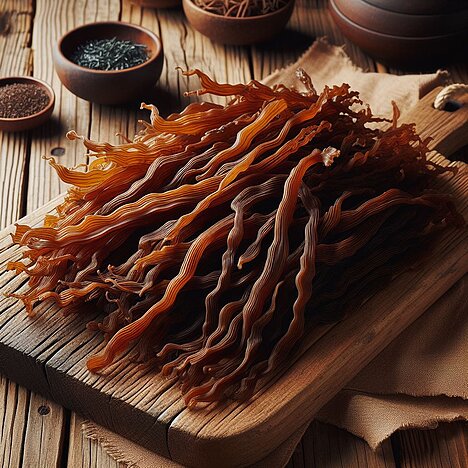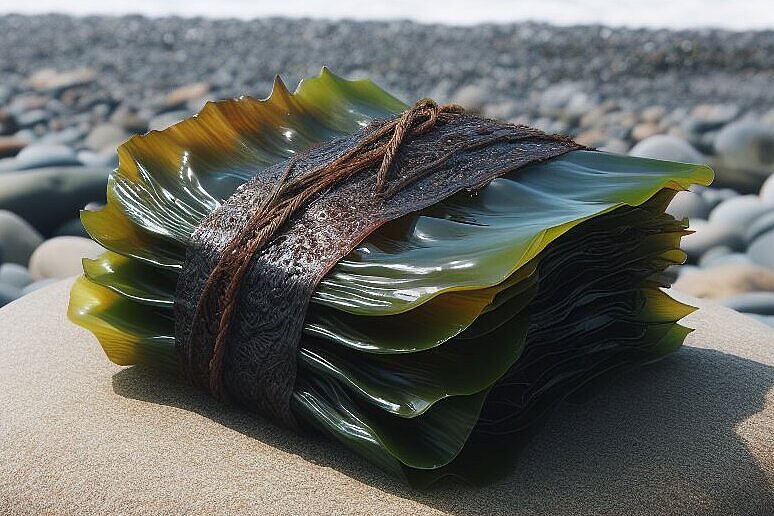Macaw

What is arame?
Arame (Eisenia bicyclis) is a dark brown seaweed that is mainly found in the cold waters around Japan. It is characterized by its fine, thread-like strands, which develop a sweetish note after drying. In Japanese cuisine, arame is prized for its mild taste and versatility. It is also rich in minerals, vitamins and other bioactive compounds, making it an interesting candidate for dogs' diets.
Benefits of arame for dogs
Rich in nutrients
Arame is known for its high content of iodine, iron, calcium and magnesium. These minerals are essential for the maintenance of various bodily functions in dogs, including metabolism, blood formation and bone health. In addition, Arame contains vitamin A, vitamin K and various B vitamins that can contribute to overall health.
Support for thyroid function
The high iodine content in Arame can support healthy thyroid function, which is especially important for dogs suffering from thyroid problems. Adequate thyroid function is crucial for regulating metabolism and maintaining healthy energy levels.
Digestive properties
Arame also contains soluble fibers that can promote intestinal health and support regular digestion. This fiber may help reduce the risk of digestive disorders such as diarrhea or constipation.
Disadvantages and precautions
Toxicity risk
Despite its nutritional benefits, arame also carries potential risks. Seaweed can absorb heavy metals such as arsenic, lead and mercury from seawater. Excessive intake of these heavy metals can be harmful to dogs and should therefore be avoided.
Overdose of iodine
Another consideration is the possibility of iodine overdose. Although iodine is an important nutrient, too much intake can disrupt thyroid function and lead to health problems. It is important to feed arame only in moderate amounts and ideally under the supervision of a veterinarian.
Allergic reactions
As with any new food ingredient, there is a risk of allergic reactions with Arame. Watch your dog carefully for signs of allergy, such as skin rashes, itching or digestive problems, especially after introducing Arame into the diet for the first time.
Arame offers an interesting way to enrich your dog's diet with a marine superfood. Its nutrient-rich composition can provide various health benefits, from supporting thyroid function to promoting digestive health. However, it's important to consider the potential risks and only use arame in moderation.
Properties 13
Are you looking for other ingredients with a specific property?
Just click on them to find more.
If you notice any signs of hypersensitivity or poisoning in your dog, you should see your vet immediately. We are not a substitute for a vet, but we try to be as accurate as possible. Every dog reacts differently and we recommend you get a second opinion or consult your vet if in doubt.
Stay healthy and take good care of your four-legged friend!😊
Similar to Macaw
Kombu is a brown algae that belongs to the genus Laminaria. It grows in cold seas and forms long, leathery leaves with finger-like appendages. Kombu is mainly cultivated and harvested in Japan,...
Wakame (Undaria pinnatifida) is a marine brown algae species that was originally native to the coasts of East Asia. However, due to its invasive nature, it has now spread to many other seas. Wakame...
Nori is a seaweed that grows in shallow waters. It is harvested, washed, pressed into thin sheets and dried. Nori has a dark green color and a mild taste. It is rich in protein, fiber, minerals and...
Hijiki (Sargassum fusiforme) is a seaweed known for its long, thread-like fronds that can grow up to several meters in length. After harvesting, hijiki is dried and then forms small, hard pieces...



